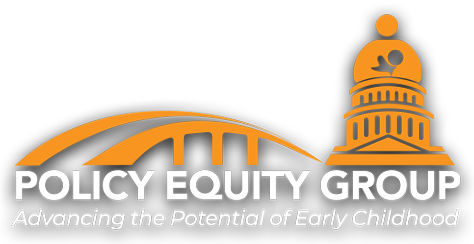For the last six years, the Policy Equity Group has provided technical assistance to nine states implementing Farm to Early Care and Education (ECE) programs. As Farm to ECE expands across the country, programs and partners are eager to share the positive impacts of Farm to ECE on children, families, ECE providers, local food systems, and communities.
To tell these stories — and lessons learned — to families, other programs, funders, and policymakers, there is a need for evaluation tools and guidance. So, in partnership with the National Farm to School Network, we created the Farm to Early Care and Education Shared Metrics resource.
What is Farm to ECE?
Farm to ECE is a community-level program that supports whole-child development through increased access to local foods, edible gardens, and food and agricultural education. It engages children in all types of ECE settings (e.g., preschools, child care centers, family child care homes, Head Start/Early Head Start, programs in K-12 school districts) with the goals of emphasizing experiential learning opportunities; parent and community engagement; and life-long health and wellness for children, families, and caregivers.
A decade ago, many programs across the country were implementing Farm to ECE activities, but it wasn’t a defined concept. More recently, expanding and building off the momentum of the wider local foods movement, Farm to ECE is becoming integrated in state early childhood plans, in systems to measure quality, and in thriving programs across the United States.
Measuring the benefits
To date, the benefits of Farm to ECE are evident and frequently reported through qualitative case studies and published journal articles. But the comparative evaluations are harder to identify. In 2014, the National Farm to School Network published Evaluation for Transformation: A Cross Sectoral Evaluation Framework for Farm to School. While referenced as a starting point for the Farm to ECE community in collecting more quantitative evidence, the differences in ECE and K-12 systems limit its utility for programs serving children before they enter school, creating a need for resources and tools specific to Farm to ECE.
The publication released this week, Farm to Early Care and Education Shared Metrics, is intended for Farm to ECE practitioners and evaluators to guide planning, implementation, research, evaluation, and reporting efforts. The resource presents a set of indicators and metrics specific to Farm to ECE and, importantly, emphasizes metrics related to equity. The resource also identifies existing research tools (e.g., surveys, observation protocols) that practitioners and researchers can use.
The Farm to ECE Shared Metrics tool is accompanied by a “User Guide and Framing Resource” that serves as a roadmap and instruction manual for potential users. In addition to providing the theoretical framework behind the tool, the user guide explains how this tool aligns and builds on preexisting evaluation efforts, giving credit to the body of knowledge and work that have already come from Michigan State University, the National Farm to Institution Metrics Collaborative, and Go NAPSACC from the University of North Carolina at Chapel Hill.
The primary benefit of the Farm to ECE Shared Metrics resource is that it provides a wide “menu of options.” Users can pick and choose which outcomes are of greatest interest to their particular Farm to ECE model and for the research questions they are most interested in, and then use the resource to identify relevant indicators, measures, and metrics. In this way, it mirrors the implementation of Farm to ECE programming, which is never intended to be everything to everyone but rather to be a customizable, flexible model designed to meet individual program and community needs.
To help put this resource in action, the Policy Equity Group is planning a webinar that will provide additional explanation and training on its use. We hope you’ll join us later this summer to learn more and integrate it into your own work! In the meantime, please see this orientation video for an overview of how to use the resource.
To read more about the resource, follow these links:


